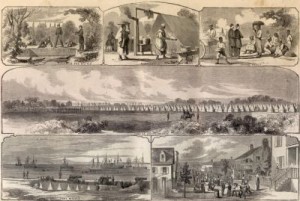In the heart of winter a military campaign in North Carolina offers a glimpse into the likely outcome of the war.
The town of Newbern (or New Bern) came under attack earlier in the month … by Confederate forces. Located in eastern North Carolina, the Union-controlled town represented an unwelcome dilemma for the Confederacy.
In short, the low country region of North Carolina, comprised largely of poor white farmers and fishermen who resent wealthy planters for starting the war while exempting themselves from military service, has never supported the rebellion against the United States. Within the past year their resistance to Confederate conscription laws have led many to sign up for service in the Union Army, with the promise of protection, amnesty and food. As a result, a large number of North Carolinians are now federal soldiers, including many former Confederate soldiers who deserted and then donned Union blue.
Against this backdrop, some 13,000 Confederate troops two weeks earlier set out to capture Newbern from the Union and round up Union-serving North Carolinians. While the planned attack on Newbern came to naught, Confederate forces did manage to capture 53 men of Company F, 2nd North Carolina Union Volunteer Regiment in a skirmish in the vicinity of the town.
Now, commanding Confederate General George C. Pickett is enacting revenge on deserters-turned-federals in the harshest manner: death. Twenty-two of the 53 are identified as deserters, and the executions have begun in what becomes known as the Kinston hangings, so named after the town in which the hangings take place. Today, five are hanged, with more to come.
Some of the captives ask for religious rites prior to their execution. Rev. Camp, a Baptist minister from Kinston, baptizes at least one prisoner prior to his execution.
These gruesome events the month of February illustrate the extremes to which some Confederate officers will go in order to enforce loyalty among rebel soldiers. Conversely, the growing number of Confederate deserters is a vivid portrait that the war is rapidly becoming a lost cause for the South.
Meanwhile, within Union-controlled Beaufort District along the coast of South Carolina, black freedmen — the men and women over whom the war is being fought — are increasingly claiming autonomy from their Northern white supervisors. Many have purchased abandoned houses earlier confiscated by Union forces. Some have purchased land and are growing crops from which they will reap the profits. The Edgerly plantation, purchased by a collective of freedmen, is worked successfully with no white supervision.
Growing autonomy also applies to black religious institutions. Members of the African Brick Baptist Church this month declare that whites should leave their church and worship in the local “white church.” Most blacks in the region are Baptist, and there is some fear among freedmen that well-meaning Northern whites may try to persuade them to move to other denominations. An African Baptist minister on Port Royal Island expresses concern that some of his members are “dodging about under the umbrellas and parasols of other denominations.” The African St. Helena Baptist Church forms a choir without consulting whites. Collectively, the growing independence of black Baptists in the Beaufort District demonstrates that freedmen are quite capable, if given the opportunity, of autonomous living.
Thus death of white Confederate traitors in North Carolina and the new lives of former African slaves in South Carolina offer a contrast of despair and hope that points to a transformation of the South that was once unthinkable.
Sources: Philip Gerard, The Kinston Hangings (link); “America’s Civil War: Union Soldiers Hanged in North Carolina,” HistoryNet (link); J. Kenneth Davis, “Kinston Hangings” (link); Willie Lee Rose, Rehearsal for Reconstruction: The Port Royal Experiment, Athens: University of Georgia Press, 1999, 1964, pp. 314-315 (link)



